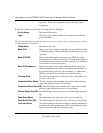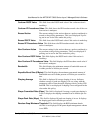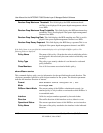
User Manual for the NETGEAR 7300S Series Layer 3 Managed Switch Software
Quality of Service (QoS) Commands 11-29
202-10088-01, March 2005
Note: Queue depth management defaults to tail drop, but the randomdrop command can be used
to change to a RED scheme.
Format
shape peak <1-4294967295> <1-4294967295>
Mode Policy-classmap Config
Restrictions Neither of the shaping rate parameters is allowed to exceed the
maximum link data rate of the interface to which the policy is
applied.
Policy Type Out
Incompatibilities Expedite (all forms)
Service Commands
The 'service' command set is used in DiffServ to define:
Traffic Conditioning Assign a DiffServ traffic conditioning policy (as specified by the
policy commands) to an interface in the incoming direction
Service Provisioning Assign a DiffServ service provisioning policy (as specified by the
policy commands) to an interface in the outgoing direction
The service commands attach a defined policy to a directional interface. Only one policy may be
assigned at any one time to an interface in a particular direction. The policy type (in, out) must
match the interface direction to which it is attached.
This set of commands consists of service addition/removal.
The CLI command root is
service-policy
service-policy
This command attaches a policy to an interface in a particular direction. The command can be used
in the Interface Config mode to attach a policy to a specific interface. Alternatively, the command
can be used in the Global Config mode to attach this policy to all system interfaces. The direction
value is either in or out. The <
policyname> parameter is the name of an existing DiffServ policy,
whose type must match the interface direction. Note that this command causes a service to create a
reference to the policy.
Note: This command effectively enables DiffServ on an interface (in a particular direction). There
is no separate interface administrative 'mode' command for DiffServ.


















